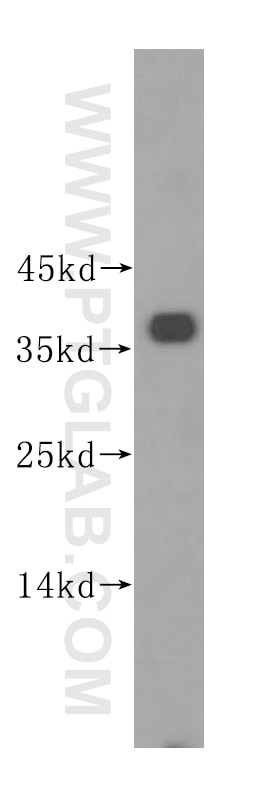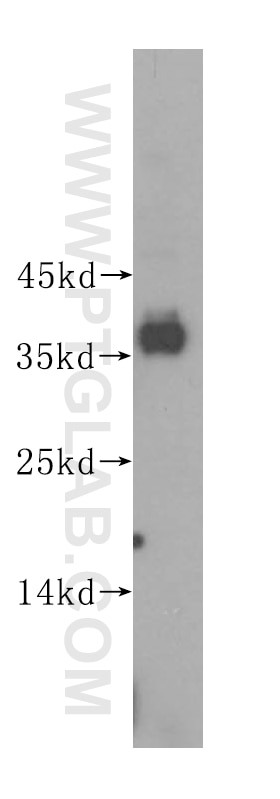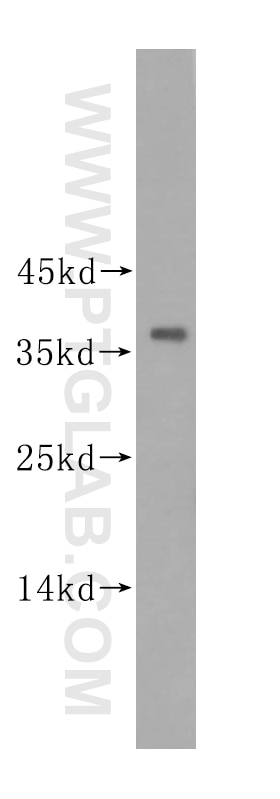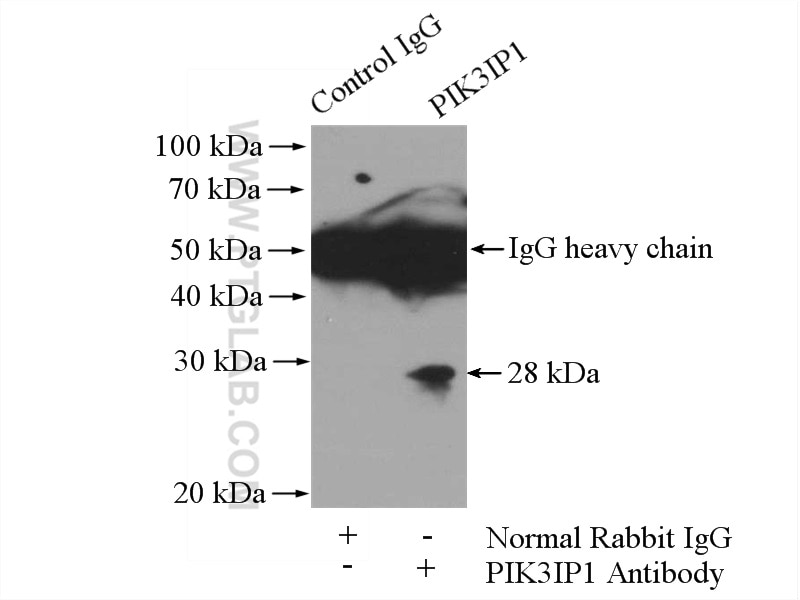Tested Applications
| Positive WB detected in | HeLa cells, HepG2 cells, mouse liver tissue |
| Positive IP detected in | HeLa cells |
Recommended dilution
| Application | Dilution |
|---|---|
| Western Blot (WB) | WB : 1:500-1:2000 |
| Immunoprecipitation (IP) | IP : 0.5-4.0 ug for 1.0-3.0 mg of total protein lysate |
| It is recommended that this reagent should be titrated in each testing system to obtain optimal results. | |
| Sample-dependent, Check data in validation data gallery. | |
Published Applications
| KD/KO | See 4 publications below |
| WB | See 15 publications below |
| IF | See 1 publications below |
| CoIP | See 1 publications below |
Product Information
16826-1-AP targets PIK3IP1 in WB, IF, IP, CoIP, ELISA applications and shows reactivity with human, mouse, rat samples.
| Tested Reactivity | human, mouse, rat |
| Cited Reactivity | human, mouse, rat, chicken, bovine |
| Host / Isotype | Rabbit / IgG |
| Class | Polyclonal |
| Type | Antibody |
| Immunogen | PIK3IP1 fusion protein Ag10427 Predict reactive species |
| Full Name | phosphoinositide-3-kinase interacting protein 1 |
| Calculated Molecular Weight | 263 aa, 28 kDa |
| Observed Molecular Weight | 37 kDa |
| GenBank Accession Number | BC011049 |
| Gene Symbol | PIK3IP1 |
| Gene ID (NCBI) | 113791 |
| RRID | AB_2163333 |
| Conjugate | Unconjugated |
| Form | Liquid |
| Purification Method | Antigen affinity purification |
| UNIPROT ID | Q96FE7 |
| Storage Buffer | PBS with 0.02% sodium azide and 50% glycerol pH 7.3. |
| Storage Conditions | Store at -20°C. Stable for one year after shipment. Aliquoting is unnecessary for -20oC storage. 20ul sizes contain 0.1% BSA. |
Background Information
PIK3IP1(Phosphoinositide-3-kinase-interacting protein 1) is also named as HGFL. The class IA phosphoinositol-3-kinases (PI3Ks) regulate important cellular processes such as proliferation, growth, survival, motility and metabolism. PIK3IP1 is a transmembrane protein that possesses a region in its intracellular domain that shares homology with the p85 regulatory subunit of PI3K. It has 5 isoforms produced by alternative splicing with the MW of 11, 18, 19, 25,28 kDa. PIK3IP1 undergoes N- and O-linked amino acid glycosylation. The major glycosylated form of PIK3IP1 migrates at about 43 kDa in western blot analysis, while the unglycosylated form migrates at 37 kDa. It is also detected a 65 kDa variant in HepG2 cell lysate that PIK3IP1 is indeed membrane bound and that these variants arise from alternative splicing and/or post-translational processing events such as enzymatic proteolysis and/or glycosylation. (PMID:18632611).
Protocols
| Product Specific Protocols | |
|---|---|
| WB protocol for PIK3IP1 antibody 16826-1-AP | Download protocol |
| IP protocol for PIK3IP1 antibody 16826-1-AP | Download protocol |
| Standard Protocols | |
|---|---|
| Click here to view our Standard Protocols |
Publications
| Species | Application | Title |
|---|---|---|
Cell Distinct Regulation of Th17 and Th1 Cell Differentiation by Glutaminase-Dependent Metabolism. | ||
Nat Commun Dual blockade of the lipid kinase PIP4Ks and mitotic pathways leads to cancer-selective lethality.
| ||
Oncogene PPM1D activity promotes cellular transformation by preventing senescence and cell death | ||
J Immunol Cutting Edge: Foxp1 Controls Naive CD8+ T Cell Quiescence by Simultaneously Repressing Key Pathways in Cellular Metabolism and Cell Cycle Progression. | ||
Sci Rep Downregulation of PIK3IP1 in retinal microglia promotes retinal pathological neovascularization via PI3K-AKT pathway activation |









